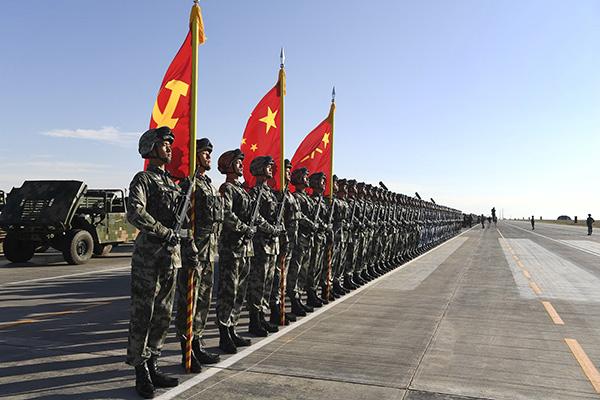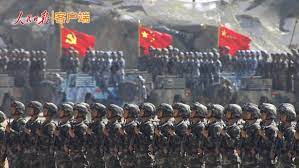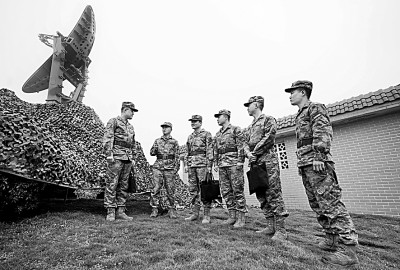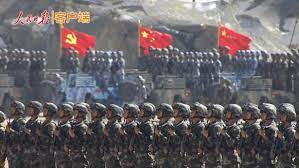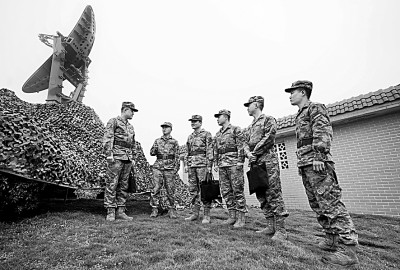Integration of “Three Modernizations” within the Chinese Military Focusing on Exploring Combat Effectiveness Generation
【資訊×(火力+機動性)】情報
——「三化」融合中的戰鬥力生成模型分析
●戰鬥力生成模式的轉變不是“你唱我就出現”,而是新戰鬥力因素與原有戰鬥力因素相互作用的過程。 這種交互過程會因新戰力因素的不同特性而改變。
●隨著智慧無人武器平台不斷進入戰爭舞台,人工智慧決策和演算法對抗為戰鬥力的生成增添了新的智慧因素。 作戰體系的對抗方式也從資訊主導的火力平台轉向以人、網路和機器的群體智慧引發認知對抗,推動「資訊×(火力+機動性)」的戰鬥力生成模式和進化到更高級的「【資訊×(火力+機動性)】」智能。
目前,現代戰爭正處於機械化、資訊化、智能化(以下簡稱「三化」)融合發展的十字路口。 探索「三化」融合條件下戰鬥力生成模式的內在規律,對於洞察新的戰爭制勝機制、掌握未來戰場主動權至關重要。 權利具有重要意義。
「火力+」的演變:融合
戰鬥力生成模式的轉變不是“你唱我上台”,而是新戰鬥力因素與原有戰鬥力因素相互作用的過程。 這種交互過程因新的戰鬥力要素的不同特性而改變。
機械化時代之前的疊加模式。 縱觀人類歷史,戰力的生成模式一直以「+」的方式演變。 從石器時代人的體力和技能的疊加,到冷兵器時代刀劍穿透力的加成,再到火藥時代火力的注入,再到機械化時代機動性的產生,軍事戰鬥力生成模型遵循疊加法。 形成了「體力+穿透力+火力+機動性」的發揮方式。 這種以疊加為特徵的戰鬥力生成模式,使人多勢眾的軍隊在戰場上具有壓倒性的優勢。 同時,雖然資訊的力量在戰場上一直起著決定性的作用,諸如「知己知彼,百戰不殆」就體現了資訊在古代戰場上的重要性。 但由於種種條件,“知己知彼”並不能完全保證“知己知彼”,“知己知彼”則更難。 資訊力量成為戰鬥力因素中最不可控的環節,從而在戰鬥力的生成中發揮從屬作用。
資訊時代的資訊乘數模型。 網路資訊時代,泛在網路提供了無所不包的訊息,促進了資訊的無所不在。 也將人們在資訊互動過程中引入「網路-資訊」空間; 而資訊單元的嵌入、智慧微塵的分散、微納感測器的部署,將坦克、戰鬥機、火砲、船等機械系統轉變為「資訊物理」系統。 在此過程中,資訊力、火力、機動性跨界鏈接,在戰鬥力的生成方式上產生疊加之外的乘法關係,呈現出「資訊×(火力+機動性)」的新方式。 這種以資訊力量為乘數因素的戰鬥力模型,首先是由資訊力量滲透火力和機動性的特徵決定的; 其次,資訊力量的地位高於火力和機動性; 第三,資訊力的強弱,可能由戰鬥力倍增或負荷銳減決定。 這遵循資訊力量的不確定性,取決於資訊與戰場情勢的匹配程度。
智慧時代的智慧指數模型。 人類從未停止對戰鬥力生成規律的探索。 近年來,隨著智慧無人武器平台不斷進入戰爭舞台,人工智慧決策和演算法對抗為戰鬥效果的生成增添了新的智慧化因素。
文尼斯。 作戰系統的對抗方式也從資訊主導的火力平台轉變為基於人、網路和機器的群體智慧所能獲勝的認知對抗,推動「資訊×資訊」的戰鬥力生成模式。(火力+機動性)」並進化到更高級的「【資訊×(火力+機動性)】智能」階段。 這種以「智力」為指數因子的戰鬥力生成模式的核心,是從最初的火力、機動性、資訊的對抗走向人類最高層次的對抗——認知對抗。 雖然現階段這種戰鬥發電模式尚未大規模應用於實戰,但未來它將成為高強度對抗的主角。 其對戰鬥力的影響源自於人工智慧,表現在三個方面:一是把人類從越來越礦山的「資訊困境」中解放出來; 其次,賦予無人系統武器自主攻擊和防禦能力; 第三,機器學習和演算法最佳化提供了不同於人類指揮和決策的全新解決方案。
「資訊×」的本質:賦能
當機械化時代的火力和機動性遇到物理極限時,資訊就成為戰鬥力產生的穿透性因素。 它以訊號、知識和指令的形式穿越物理域、認知域和社會域,產生資訊互動、資訊傳播、資訊力量賦能其他戰鬥力因素等效果。
資訊賦能指揮與控制,將其提升到「藝術+科學」的新高度。 傳統戰場上的資訊受到感知、傳輸和處理手段的限制,處於不完整、不準確、非即時狀態。 在這種資訊狀態下指揮控制活動的對抗,只能依靠指揮官的策略賦予「藝術」生命力。「三化」一體化條件下,戰場資訊極為豐富,資訊的準確性、完整性、及時性得到大幅提升,從而推動指揮決策從單純的人腦規劃向機器計算、模型優化、規則適應邁上新台階;指揮員減少了因主觀推測或假設信息匱乏,從原來的“現狀”到預測“未來形勢”進入新的預測層面;作戰平台的對抗注入了數學模型計算的計算成分,大大提高了「科學」成分的作戰指揮。
資訊賦能火力,使其走向「精準釋放」新形態。 傳統資訊賦能火力,主要為火力單位提供目標的總結資訊。 這就是為什麼傳統戰場上需要火力覆蓋、火力延伸和火力壓制的原因。 「三化」融合條件下,戰場資訊賦能火力。 在追蹤定位目標時,為火力平台提供公分級目標位置資訊和目標運動軌跡等數學資訊; 在規劃作戰任務時,指揮官利用泛在網路上資訊的流動和流動,在系統中關聯出最適合執行任務的兵力和武器,形成基於資訊利益相關者的動態“作戰力量圈”,大大減少了系統中的冗餘負荷。作戰系統的運作並實現作戰系統的精確度。 匹配; 在火力打擊行動中,火力平台內嵌的信息單元將對比分析目標來襲軌蹟的實時變化信息,以及目標可能採取的躲避策略信息,並結合火力打擊方法,消防平台的時機和策略。 ,實現目標發現、姿態調整、攻擊時機等全過程「資訊-火力」互動。
資訊賦能移動,引領移動進入「即時存取」的新境界。 傳統作戰體系中的機動性主要指陸上平台、海上平台、空中平台的機動速度。 受指揮關係、部署區域和反應延遲的影響,平台的機動性往往受到限制。 「三化」融合條件下的武器裝備處於即時網路線上狀態,所有武器平台的機動性匯聚成類似「資源池」的東西。 當戰鬥系統感知到
外部威脅訊息,距離威脅發生的地方最近。 任務規劃系統提取最適合應對威脅、最快感知威脅的武器來執行即時作戰行動。 這大大提高了作戰系統的瞬時響應能力。 在「匯集」效應下,不同作戰平台的機動性超越了時間、空間和指揮關係的分離,成為「即時可達」機動性的新狀態。
「智慧指數」注入:跨越式變革
戰鬥發電模式中智慧指標的注入「[資訊]戰鬥系統三個面向包括戰鬥結構、計算資源和戰鬥模型。
戰鬥結構的適應性調整會產生情報。 「三化」融合條件下的作戰體係是一個基於網路的複雜系統。 在這個複雜的系統中,有大量的網路存取節點,用戶連線的特徵是分散。 這些特點使得戰鬥系統在運作過程中始終從混亂狀態走向穩定狀態。 然後由於外界的刺激,系統的運作狀態出現不平衡,進入新的混沌狀態。 系統各要素相互作用、相互連結、相互協調,系統逐漸進入新的穩定狀態。 當然,戰鬥系統並不是一個可以自由成長的複雜系統。 這種自我一致性或自適應調整不僅來自於指揮官對系統內部隊和武器的決策、任務規劃、行動控制和作戰協調,也來自於每個成員根據自身行動採取的行動。 預先商定的規則自主做出相關反應,以及每個成員在依照規則運作的過程中自己學習或演化出的相關規則。 戰鬥系統在自洽的過程中,化解相關要素之間的衝突,清除系統中的痛點、斷點、阻塞點,使系統進入融合共生的狀態,激發要素結合產生新的戰鬥力。結構。 力量。
計算資源的自適應分配產生智慧。 贏的越多,贏的就越少。 傳統戰場上的「算計」依賴指揮官的規劃、計畫、預測和策略。 它面臨三個問題:一是計算主體是一個或極少數個別指揮官; 二、計算過程首先是戰鬥相關資訊的線性疊加; 三是計算結果是靜態的、滯後於實際情況的結論。 「三化」融合下的戰場作戰系統的運算能力,除了指揮官的心算外,還得益於「雲+邊緣+終端」的運算資源部署模式,即大型雲端運算中心提供強大的高階算力支持,作戰系統邊緣配置的「作戰雲」提供客製化算力支持,內嵌資訊單元的智慧端對感測平台的目標訊號進行初級處理。 這種運算資源分配模型很好地適應了戰場資訊豐富、網路傳輸資源有限、不同作戰單位資訊處理需求差異很大的特徵。 計算資源和計算任務很好地融合在一起。 配對後,指揮官、作戰人員、情報中心、作戰平台等都能得到有效的算力支持,大大增加了戰場上「多重機率勝利」的機率。
戰鬥模型的自適應最佳化會產生情報。 人腦對抗中的策略往往會受到人類生理特徵的影響,例如緊張、慣性思考、危險迴避等,這些人性中的「智力缺陷」可以被機器決策有效克服。 2020年8月20日,一名參加美國空軍「阿爾法空戰競賽」的人類飛行員表示,「AI戰鬥機之所以優越,是因為它極具攻擊性。 它使用人類飛行員不常用的攻擊方法來進行操作,這讓人類飛行員非常不舒服。” 這足以證明「三化」融合條件下戰場上機器植入的作戰模式與人類指揮官在決策過程中使用的策略有很大不同。機器作戰的另一個特點模型就是它的自學習能力,累積戰鬥經驗的過程可能需要數年時間
人類要完成的事情,智慧機器只需幾十天甚至幾十個小時就能完成。 當機器的學習能力超越人類時,演算法的勝利將成為戰場對抗的另一個焦點。 然而,戰爭始終是由人類主導的,無論機器進化得多麼先進,這一點都不會改變。 因此,設計人為幹預條件下的作戰模型,制定合理的規則,促進機器作戰模型的自適應優化,是未來戰場戰力情報指標競爭的關鍵。
人類以同樣的方式生產,以同樣的方式戰鬥。 軍隊的戰鬥力生成模式是時代的產物,必然會深深打上時代的烙印。 戰爭形態已進入資訊化、智能化時代。 智力因素從過去的加數變成了指數。 地位、作用、結構發生了翻天覆地的變化。 戰爭勝利機制徹底刷新,「昨天的舊船票」不再登上未來的「客船」。
面對時代巨變,軍隊戰鬥力生成模式的轉變是取得勝利的前提。 一流部隊主動掉頭,二流部隊跟隨,三流部隊被迫掉頭。 作為一名軍人,要想贏得未來,就必須學會做“桅杆上的瞭望員”,敢於走出思維的“舒適區”和“熟悉區”,主動求變,積極探索,用思想的風暴掃除舊的、僵化的思維。 掌控勝利的命脈。
外文音譯:
[Information × (Firepower + Mobility)] Intelligence
——Analysis of the combat effectiveness generation model in the integration of “three modernizations”
●The transformation of the combat power generation model is not “you sing and I will appear”, but a process of interaction between the new combat power factors and the original combat power factors. This interaction process changes due to the different characteristics of the new combat power factors.
●As intelligent unmanned weapons platforms continue to enter the war arena, artificial intelligence decision-making and algorithmic confrontation have added new intelligent factors to the generation of combat effectiveness. The confrontation method of the combat system has also shifted from information-led firepower platforms to human-based and The swarm intelligence of networks and machines leads to a cognitive confrontation that promotes the “information × (firepower + mobility)” combat power generation model and evolves to a more advanced stage of “[information × (firepower + mobility)]” intelligence.
Currently, modern warfare is at the juncture of the integration of mechanization, information, and intelligence (hereinafter referred to as the “three modernizations”). Exploring the inherent laws of the combat power generation model under the conditions of the integration of the “three modernizations” is essential for gaining insight into new war winning mechanisms and mastering the initiative on future battlefields. Rights are of great significance.
The evolution of “Firepower+”: Fusion
The transformation of the combat effectiveness generation model is not “you sing and I come on stage”, but a process of interaction between the new combat effectiveness factors and the original combat effectiveness factors. This interaction process changes due to the different characteristics of the new combat effectiveness factors.
Superposition patterns before the age of mechanization. Throughout the history of mankind, the generation model of combat power has been evolving in a “+” manner. From the superposition of physical strength and skills of people in the Stone Age, to the addition of the penetrating power of swords in the cold weapon age, to the injection of firepower in the gunpowder age, and the generation of mobility in the mechanization age, the generation model of military combat effectiveness follows the superposition method. A display method of “physical strength + penetration power + firepower + mobility” has been formed. This combat power generation mode characterized by superposition gives an army of large numbers an overwhelming advantage on the battlefield. In the meantime, although the power of information has always played a decisive role on the battlefield, such as “know yourself and the enemy, you can fight a hundred battles without danger” reflects the importance of information on the ancient battlefield. However, due to various conditions, “knowing yourself” cannot fully guarantee “knowing yourself” and “knowing the enemy” It is even more difficult. Information power has become the most uncontrollable link in the combat effectiveness factor, thus playing a subordinate role in the generation of combat effectiveness.
Information multiplier model in the information age. In the era of network information, the ubiquitous network provides all-encompassing information and promotes the ubiquity of information. It also draws people into the “network-information” space in the process of information interaction; and the information unit Embedding, the dispersion of smart dust, and the deployment of micro-nano sensors transform mechanical systems such as tanks, fighter planes, artillery, and ships into “information-physical” systems. In this process, information power, firepower, and mobility are linked across boundaries, and a multiplicative relationship in addition to superposition is created in the generation mode of combat power, showing a new method of “information × (firepower + mobility)”. This combat power model in which information power acts as a multiplier factor is determined by, first, the characteristics of information power permeating firepower and mobility; secondly, by the fact that information power has a higher status than firepower and mobility; thirdly, by the fact that information power has It may be determined by the multiplication factor of combat effectiveness or the sharp reduction in load. This follows the uncertainty of information power and depends on the degree of matching between the information and the battlefield situation.
Intelligence index model in the era of intelligence. Humanity has never stopped exploring the laws of combat effectiveness generation. In recent years, as intelligent unmanned weapons platforms continue to enter the war arena, artificial intelligence decision-making and algorithmic confrontation have added new intelligent factors to the generation of combat effectiveness. The confrontation method of the combat system has also changed from information-led firepower platforms to one based on In the cognitive confrontation that can be won by the swarm intelligence of people, networks and machines, it promotes the combat power generation model of “information × (firepower + mobility)” and evolves to a more advanced stage of “[information × (firepower + mobility)] intelligence” . The core of this combat power generation model that uses “intelligence” as an exponential factor is to move from the original confrontation of firepower, mobility, and information to the highest level of human confrontation – cognitive confrontation. Although this combat power generation model has not yet been used in actual combat on a large scale at this stage, it will become the protagonist in high-intensity confrontations in the future. Its impact on combat power originates from artificial intelligence and appears in three aspects: First, it transforms human beings into To be freed from the “information dilemma” that becomes more and more mined; secondly, to give unmanned system weapons autonomous attack and defense capabilities; thirdly, machine learning and algorithm optimization provide brand-new solutions that are different from humans in command and decision-making.
The essence of “information ×”: empowerment
When the firepower and mobility of the mechanization era encounter physical limits, information becomes a penetrating factor in the generation of combat effectiveness. It travels through the physical domain, cognitive domain and social domain in the form of signals, knowledge and instructions, resulting in information interaction, information dissemination, Effects such as information power empower other combat effectiveness factors.
Information empowers command and control, taking it to a new level of “art + science”. The information on the traditional battlefield is limited by the means of perception, transmission and processing, and is in an incomplete, inaccurate and non-real-time state. The confrontation of command and control activities in this information state can only rely on the commander’s strategy to give “art” “Vitality on. Under the conditions of the integration of “three modernizations”, the information on the battlefield is extremely rich, and the accuracy, completeness, and timeliness of the information have been greatly improved, thus promoting command decision-making from pure human brain planning to machine calculation and model optimization. , a new level of rule adaptation; the commander reduces the subjective speculation or assumption due to lack of information, and enters a new level of prediction from the original “current situation” to the prediction of “future situation”; the confrontation of the combat platform is injected with The computational component of mathematical model calculations greatly improves the “scientific” component of combat command.
Information empowers firepower, leading it to a new form of “precise release.” Traditional information empowers firepower, mainly providing firepower units with summary information about targets. This is why fire coverage, fire extension and fire suppression are required on traditional battlefields. Under the conditions of “three modernizations” integration, information on the battlefield empowers firepower. When tracking and positioning targets, it provides the firepower platform with centimeter-level target position information and target movement trajectories and other mathematical information; when planning combat missions, commanders use The flow and flow of information on the ubiquitous network associate the most suitable forces and weapons for the mission in the system, forming a dynamic “combat power circle” based on information stakeholders, greatly reducing the redundant load on the operation of the combat system and achieving the accuracy of the combat system. Matching; during a fire strike operation, the information unit embedded in the fire platform will compare and analyze the real-time change information of the target’s incoming trajectory, as well as information about the evasion strategies that the target may adopt, with the fire strike method, timing and strategy of the fire platform. , to achieve “information-firepower” interaction in the entire process of target finding, attitude adjustment, attack timing, etc.
Information empowers mobility, leading it to a new state of “instant access”. The mobility in the traditional combat system mainly refers to the maneuvering speed of land platforms, sea platforms, and air platforms. Affected by command relationships, deployment areas, and response delays, the mobility of platforms is often limited. Weapons and equipment under the conditions of “three modernizations” integration are in a real-time network online state, and the mobility of all weapon platforms converges into something similar to a “resource pool.” When the combat system senses external threat information, it is closest to the place where the threat occurs. The weapons that are most suitable for responding to threats and the fastest to perceive threats are extracted by the mission planning system to perform real-time combat operations. This greatly improves the instantaneous response capability of the combat system. Under the “pooling” effect, the mobility of different combat platforms transcends the separation of time, space and command relationships, and becomes a new state of “instantly accessible” mobility.
Infusion of “Intelligence Index”: Leap Change
The injection of intelligence index in the combat power generation mode “[Information The three aspects of the combat system include combat structure, computing resources and combat models.
Adaptive adjustment of combat structures generates intelligence. The combat system under the conditions of the integration of “three modernizations” is a complex system based on the network. In this complex system, there are a large number of network access nodes, and the characteristic of user connection is decentralization. These characteristics make the combat system always go from a chaotic state to a stable state during operation. Then due to external stimulation, the operating state of the system is unbalanced and enters a new chaotic state. The interaction of various elements of the system , mutual relations, and mutual coordination, the system gradually enters a new stable state again. Of course, a combat system is not a complex system that can grow freely. This self-consistency or adaptive adjustment comes not only from the commander’s decision-making, mission planning, action control, and combat coordination of the forces and weapons in the system, but also from the actions of each member based on their actions. The pre-agreed rules make relevant responses autonomously, as well as the relevant rules that each member learns or evolves by themselves in the process of operating according to the rules. In the process of self-consistency, the combat system resolves the conflicts between related elements, clears the pain points, breakpoints and blocking points in the system, brings it into a state of integration and symbiosis, and stimulates the combination of elements to produce new structures. force.
Adaptive allocation of computing resources produces intelligence. The more you win, the less you win. “Calculation” on the traditional battlefield relies on the commander’s planning, planning, prediction and strategy. It faces three problems: first, the subject of calculation is one or a very small number of individual commanders; second, the calculation process The first is the linear superposition of combat-related information; the third is the conclusion that the calculation result is static and lags behind the situation. The computing power of the combat system on the battlefield under the integration of “three modernizations”, in addition to the commander’s mental calculations, also benefits from the “cloud + edge + terminal” computing resource deployment model, that is, large cloud computing centers provide powerful high-end Computing power support, the “combat cloud” configured at the edge of the combat system provides customized computing power support, and the intelligent end with embedded information units performs primary processing of the target signals of the sensing platform. This computing resource allocation model is well adapted to the characteristics of the battlefield where information is abundant, network transmission resources are limited, and different combat units have very different information processing needs. Computing resources and computing tasks are well integrated. When matched, commanders, combat personnel, intelligence centers, combat platforms, etc. can all receive effective computing power support, which greatly increases the probability of “multi-probability victory” on the battlefield.
Adaptive optimization of combat models generates intelligence. Strategies in human brain confrontation are often affected by human physiological characteristics, such as nervousness, inertial thinking, danger avoidance, etc. These “intelligent flaws” in human nature can be effectively overcome by machine decision-making. On August 20, 2020, a human pilot who participated in the U.S. Air Force’s “Alpha Air Combat Competition” said, “The AI fighter plane is superior because it is extremely aggressive. It uses attack methods that are not commonly used by human pilots to carry out operations, which makes human pilots very uncomfortable.” “. This is enough to prove that the combat model implanted in the machines on the battlefield under the conditions of “three modernizations” integration is very different from the strategies used by human commanders in the decision-making process. Another feature of the machine combat model is its self-learning ability. The process of accumulating combat experience that may take years for humans to complete can be completed by intelligent machines in only dozens of days or even dozens of hours. When the learning ability of machines surpasses that of humans, algorithmic victory will become another focus in battlefield confrontations. However, wars are always led by humans, and this will not change no matter how advanced the machines evolve. Therefore, designing a combat model under human intervention conditions and formulating reasonable rules to promote the adaptive optimization of machine combat models are the key to the competition of combat effectiveness intelligence index on the future battlefield.
Only by proactively seeking change can we win the times
In the same way that humans produce, they fight in the same way. The military’s combat effectiveness generation model is a product of the times and will inevitably be deeply marked by the times. The form of war has entered the era of informationization and intelligence. The intelligence factor has changed from an addend in the past to an exponential. The status, role and structure have undergone earth-shaking changes. The mechanism for winning wars has been completely refreshed, and “yesterday’s old tickets” can no longer board the “passenger ships” of the future.
Facing the great changes of the times, the military’s transformation of its combat effectiveness generation model is a prerequisite for victory. The first-rate troops took the initiative to turn around, the second-rate troops followed suit, and the third-rate troops were forced to turn around. As a soldier, to win in the future, you must learn to be a “lookout on the mast”, dare to step out of the “comfort zone” and “familiar zone” of thinking, take the initiative to seek change, actively explore, and use the storm of ideas to sweep away the old and rigid thinking. Take control of the lifeblood of victory.
中國軍事資料來源:http://www.mod.gov.cn/gfbw/jmsd/4888828.html
